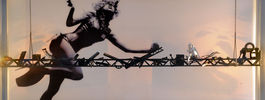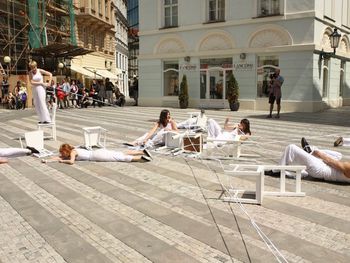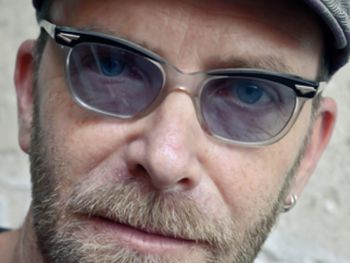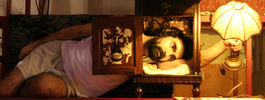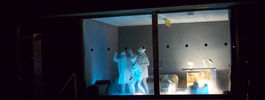Scenarist of the exhibition: Jan Fiebelkorn
On the Situation of the Theatre in the Federal Republic and
the Concept of Our Exposition
The theatre in the Federal Republic has, for a number of years, been inspired by the fruitful tensions which exist between the concepts of stage directors and the visual and scenic concepts of set and costume designers. This development has occurred only after traditional stage designs have been transformed into scenic and spatial creations and have became a purposefully developed element of work in the theatre.
The stage designers of the Federal Republic have found a source of inspiration and support for their emancipation in theatrical experiments which took place abroad, especially in Italy and France and also from the artistic experiments of the visual arts in the Federal Republic. The latter began to realize happenings and other activities already during the sixties, which aimed against a traditionally bourgeois and static approach to art. Such artists as Beuys, Vostell and Brock used theatrical factors and thus entered into an aggressive and finally active relationship with the theatre.
Artistic developments within end outside the theatre became a source of encouragement for those working in the theatre to forsake existing traditional stage spaces and to seek unusual, ordinary places, such as abandoned factory or trade fair halls, old slaughter-houses or sports stadiums.
Typical examples of the aesthetical and spatial transformations which have taken place in theatrical work can be found in a number of theaters in the Federal Republic, especially in Bochum, Stuttgart, Cologne, Frankfurt and Hamburg.
The exposition of the ^federal -republic attempts to capture and reflect these changes in the work of our theatres.
Changes in the concept of the theatre have led to a situation where an exposition containing only photographs and drawings would be of doubtful value. It was thus necessary to find a different, more modern form for the exposition: foremost stage designers, using their newest methods of work in the theatre, have designed spaces which represents brief sections of theatrical productions. The visitor to the exhibition will have the opportunity of gaining an immediate look of those stage design and stage direction methods, which in recent years have gained exceptional significance in the Federal Republic.
In our opinion, this form of our exposition makes it possible for us to provide at the Prague Quadrennial a real and immediate presentation of the theatrical work now done in the federal Republic.
- Achim Freyer
Specialization: director, set designer, costume designer
Additional information: Born in 1934. Began as industrial designer, master student of Bertolt Brecht, then stage designer. Presently, he cooperates with Burgtheater Wien, Opera Leipzig, Demut La Monnaie Brussels, Opera National du Rhin Strassbourg, Festival of Schweitzingen, Bavarian State Opera Můnchen, Festival of Salzburg and Teatro Nacionál de Don Carlos Lisbon. He exhibited at the PQ in 1975 and 1979. In 1998 he received the Award of the ITI for the World Theatre Day.
Obrázky z katalogu
- Johannes Schütz (Johannes Schuetz)
Specialization: director, set designer, costume designer
Education: studied stage design in Munich and Hamburg
Collaboration with theatres: Schauspielhaus Bochum, Schauspielhaus Düsseldorf
Teaching activities: Professor for scenography at the Centre for Arts and Media Karlsruhe
Continuing collaboration with directors: Jürgen Gosch, Reinhild Hoffmann
Obrázky z katalogu
- Herbert WERNICKE
Additional information: Bern in 1946. He first studied music in Braunschweig and in the period 1966 - 1970 he studied stage design with R. Heinrich. During the 1970 - 1971 season he was a stage designer at the Boston Opera Company in the USA, in 1971 he became the stage designer of the theatre in Landshut and in 1973 he worked at the theatre in Wüppertal. Since 1974 he is a free lance stage designer. Among his most intersting stage designs are those for productions of Brechť s Drums in the Night and The Excess of A. Bronnen, Mozarť s The Magic Flute, L. Tieck' s and F. Schiller' s Upside Down World and The Marriage by V. D. Kirchner. In 1978 ha directed and designed a production of Händel´s Belsazar for the state Theatre in Darmstadt.
Obrázky z katalogu
- Pina BAUSCH
Additional information: Born in Solingen. She studied dance at the Folkwangschule in Essen under Kurt Joosse /1955/. In 1961 she was at the Metropolitan Opera in New York and also danced in the New .American Ballet. In 1973 she became the superintendent of the Wuppertaler Tanztheater. In collaboration with R. Borzig she created har best work for the stage: Scenes from Bluebeard /1977/ and Come, Dance With Me /1977/ and He Takes Her by the Hand and Leads Her Into the Castle; the Others Follow /1978/.
Obrázky z katalogu
- Joseph BEUYS
Additional information: Born in 1921 in Kleve. In the years 1949 - 1951 he studied with
Ewald Mataré. In 1961 he came to work in the State Academy of
Art in Düsseldorf; since 1964 he has participated in the "documenta"
exhibitions held in Kassel. In 1976 he exhibited his
iron sculptures at the Biennial in Venice. In 1978 he came to
work for the Academy of Applied Arts in Vienna. He is a member
of the Berlin /West/ Academy of Arts.
A selection of photographs to clarify the relationship between
individual types of art and the theatre in the Federal Republic
of Germany.
Obrázky z katalogu
- Barbara BILABEL
Additional information: Born in 1939 in Darmstadt. She studied stage design with Willi
Schmidt in Berlin /West/. She has worked with Nils Peter Rudolph
in Berlin /West/ and in Stuttgart. She has intentionally forsaken
designing for the stage and concentrate on contributing to the forming of the character by the actor with costume designs. Besides
the theatre, she also works for films.
Obrázky z katalogu
- Ernst FUCHS
Additional information: Born in 1930 in Vienna. He is an Austrian painter, a member of
the Vienna school. In 1978 he designed the stage sets for Wag -
ner' s Lohengrin at the Bavarian State Opera in Munich.
Obrázky z katalogu
- Rolf GLITTENBERG
- Klaus Michael GRÜBER
Additional information: Born in 1941 in Neckar-Elz. Among his foremost recent designs are the sets for productions of Goethe' s Faust in Paris in 1975, Hölderlin' s Empedocles in the Berlin /West/ Schaubühne am Halleschen Ufer in 1976, The Winter Journey at the Olympic Stadium in Berlin /West/ produced by the Schaubühne am Halleschen Ufer in 1977, and the production of Rudi at the Esplanade in Berlin /West/,produced by the Schaubühne am Halleschen Ufer in 1979. The Winter Journey / film Olympiastadion directed by Klaus Michael Grüber in collaboration with Antonio Recalcati /born 1938 in Bresso in Italy who had previously collaborated with K.M. Grüber on a production of Empedocles, Winter Journey and Rudi/, with Bernard Pautrat /born 1944, a professor of philosophy, who also collaborates with André Engerl/, and with Ellen Hammer /born in 1942 in Munich, who contributed as program director/.
Obrázky z katalogu
- Gerd LOEPELMANN
Additional information: Born in 1930 in Berlin. In the years 1948 - 1953 he studied painting and since 1964 sculpture in Berlin /West/.In the period 1969 - 1970 he was an associate professor of painting at San Francisco State College in the USA. Since 1971 he is a stage designer at the theatre in Bochum. Among his most interesting work in the period 1974 - 1979 are designs for productions of King Lear, Hedda Gabler, The Wild Duck, all directed by P. Zadeck, for The Unexpected Dream /directed by A. Fernandez/, for Darwin' s Journey, which was written by Loepelmann and directed by a collective and for Atlantis /a collective design/.
Obrázky z katalogu
- Ilona Freyer
Additional information: Born in 1944 at Dessau. For a period of three years she did practical work at the work- shops of the Deutsche Staatsoper in Berlin. Between 1965 and 1970 she studied stage design art at the College of Plastic and Applied Arts in Berlin Weissensee under prof. Heinrich Kilger. Since 1971 she acts as stage designer at the Berliner Ensemble.
- Karl-Ernst Herrmann
Additional information: Born in 1936 in Neukirch/Lausitz. After studying for three years at the Meisterschule für Kunsthandwerk (in the weaving class) in he studied from 1955 to 1960 under Wolff Hoffmann and Willi Schmidt at the Hochschule für Bildende Kunste in Berlin. From 1960 to 1961 he had his first engagement in Ulm, and from 1961 to 1967 he was a member of the stage design team with Hübner/Zadek/Minks at the theatre in Bremen. From 1968 to 1970 he was at the Staatstheater Braunschweig, and since 1970 he has been a member of the cast of the Schaubühne am Halleschen Ufer in Berlin. He has recently become famous for his designs for Peter Stein's production of Ibsen's "Peer Gynt".


